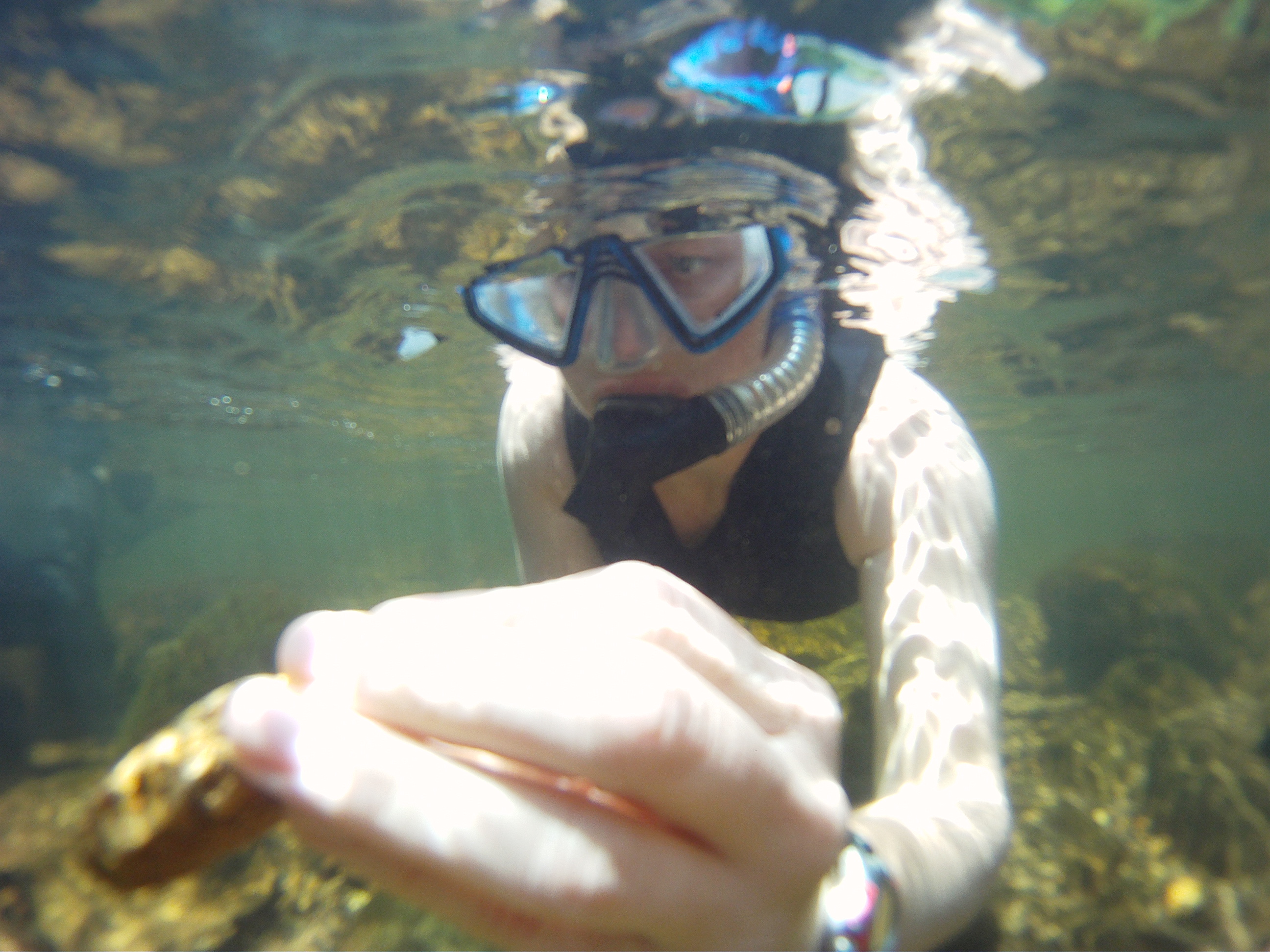Project WET: Hamilton County, Bradley County educators explore Conasauga River
Friday, January 1, 1904
 Rebecca Xiques holds up a rock as she looks for fish and invertebrates while snorkeling in the Conasauga River in Ocoee, Tenn., on Wednesday during the Project WET program. Teachers from Hamilton County and surrounding areas spent two days studying aquatic life, which included searching for invertebrates and snorkeling in the river, as part of Project WET.
Rebecca Xiques holds up a rock as she looks for fish and invertebrates while snorkeling in the Conasauga River in Ocoee, Tenn., on Wednesday during the Project WET program. Teachers from Hamilton County and surrounding areas spent two days studying aquatic life, which included searching for invertebrates and snorkeling in the river, as part of Project WET.Deep in the Cherokee National Forest, where cellphone reception dares not tread, about 30 educators from Hamilton and Bradley counties treaded the shallow Conasauga River and its inhabitants Wednesday afternoon.
The program, called Project WET for "Water Education for Teachers," brought educators to Polk County on both Tuesday and Wednesday, giving teachers opportunities to discover how to incorporate environmental education into their classroom -- be it instructing math, science, language arts or social studies.
Project WET is a national and international program and the Hamilton County Water Quality Program has helped sponsor its local version for the past seven years by paying for some transportation and providing breakfast, said Water Quality Program Manager Tim McDonald.
"We support this because it reaches our target audience -- the local teachers in our areas," he said.
The program started out with activities at the Ocoee Whitewater Center, where teachers participated in games and activities that could easily find their ways into the classrooms, said George Bartnik, education program manager of the Tennessee Aquarium.
"This all brings it to life," he said.
One activity focused on how to keep water clean. Samples of water were polluted with "motor oil" [olive oil] or "debris" [spices] and teachers had to find ways to clean it.
"This shows it's less expensive to keep water clean than it is to clean it after it's already been dirtied," Bartnik said.
About 1:30 p.m., a bus full of teachers made its way up a dusty gravel roadway and filed into the designated area at the Conasauga River, then split into two groups. Members of one group grabbed a net, rolled up their pants legs, removed their footwear and traversed the slippery moss-covered rocks in a pool, hoping to catch a critter in their net, then identify it using drawings attached to a nearby whiteboard.
They were searching for benthic macroinvertebrates -- benthic means bottom, macro means large, invertebrates are animals without a backbone -- which are good indicators of water quality.
Elaine Mahn and Amy Finn, third-grade teachers at Allen Elementary School in Soddy-Daisy, netted themselves a darter fish.
"This is by far the best workshop," said Mahn, who had also participated with Finn in last year's Project WET.
Other critters nabbed in nets included a couple of large tadpoles, two crayfish -- which nipped at the tadpoles with their pinchers as they swam by in the collection bins -- mayflies and stoneflies.
If the 30-minute investigation yielded a large variety of river-dwellers, it was a good sign, Bartnik said.
"All these are an indication of clean water," he said. "At least, for them."
Meanwhile, the other group of teachers donned wetsuits, face masks and snorkels to examine the river floor more intimately. Teachers floated effortlessly in the shallow river -- about four feet deep in some spots -- to get a good look at river life without disturbing it.
Jim Herrig, a forest aquatic biologist, emerged holding a large subspecies of turtle called the Hieroglyphic River Cooter.
"She was under a rock near a bunch of large bass," he said with the female turtle, sporting orange streaks and sharp claws, in his hands.
For three Ocoee Middle School instructors, their underwater mission allowed them to observe a sunfish heavily protecting its nest, plus some other fish and turtles.
"For math, we can use this to collect a lot of data and use that in math," said one of the trio, sixth-grade teacher Elaine Policastro. "English teachers can use it to teach students to write, and social studies teachers can use it for geography."
Another member of the trio, Joyce Key, teaches sixth-grade science and said Project WET is "a good way to connect it to reality."
"We have to teach the environment, adaptation, and why everything is important," she said.
There are 76 different types of fish in the area of the Conasauga River examined Wednesday, said Casper Cox, who served as a guide to the snorkeling teachers. Of the 76 types, about five of them are endangered, he said.
"We saw about 30 of them today," Cox said.